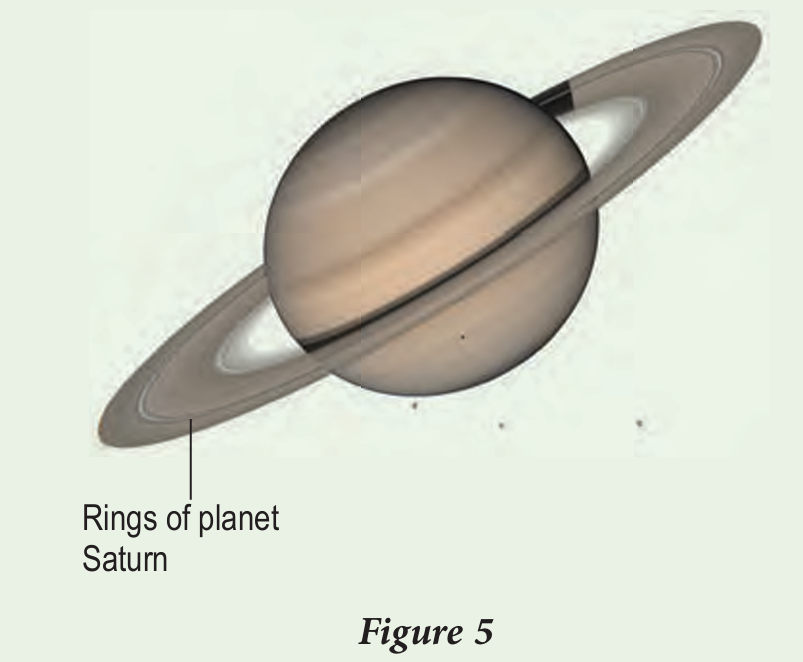Question 7:
Th e Earth orbits the Sun with radius of orbit of 1.50 × 1011 m and orbital period of 1 year. Radius of orbit of planet Saturn is 1.43 × 1012 m. What is the orbital period of Saturn?
Answer:
Orbital period of the Earth, 𝑇1=1.00 years,
Orbital period of Satrn = 𝑇2
Orbital radius of the Earth, r1 = 1.50 × 1011 m,
Orbital radius of Saturn, r2 = 1.43 × 1012 m
$$ \begin{aligned} \frac{T_1^2}{T_2^2} & =\frac{r_1^3}{r_2^3} \\ \frac{1.00^2}{T^2} & =\frac{\left(1.50 \times 10^{11}\right)^3}{\left(1.43 \times 10^{12}\right)^3} \\ T_2^2 & =\frac{1.00^2 \times\left(1.43 \times 10^{12}\right)^3}{\left(1.50 \times 10^{11}\right)^3} \\ T_2 & =\sqrt{\frac{1.00^2 \times\left(1.43 \times 10^{12}\right)^3}{\left(1.50 \times 10^{11}\right)^3}} \\ & =29.44 \text { years } \end{aligned} $$
Th e Earth orbits the Sun with radius of orbit of 1.50 × 1011 m and orbital period of 1 year. Radius of orbit of planet Saturn is 1.43 × 1012 m. What is the orbital period of Saturn?
Answer:
Orbital period of the Earth, 𝑇1=1.00 years,
Orbital period of Satrn = 𝑇2
Orbital radius of the Earth, r1 = 1.50 × 1011 m,
Orbital radius of Saturn, r2 = 1.43 × 1012 m
$$ \begin{aligned} \frac{T_1^2}{T_2^2} & =\frac{r_1^3}{r_2^3} \\ \frac{1.00^2}{T^2} & =\frac{\left(1.50 \times 10^{11}\right)^3}{\left(1.43 \times 10^{12}\right)^3} \\ T_2^2 & =\frac{1.00^2 \times\left(1.43 \times 10^{12}\right)^3}{\left(1.50 \times 10^{11}\right)^3} \\ T_2 & =\sqrt{\frac{1.00^2 \times\left(1.43 \times 10^{12}\right)^3}{\left(1.50 \times 10^{11}\right)^3}} \\ & =29.44 \text { years } \end{aligned} $$
Question 8:
A spacecraft orbits the Earth at a height of 1 600 km. Calculate the escape velocity for the spacecraft.
[G = 6.67 × 10–11 N m2 kg–2, mass of the Earth = 5.97 × 1024 kg, radius of the Earth = 6.37 × 106 m]
Answer:
$$ \text { Escape velocity, } v=\sqrt{\frac{2 G M}{(R+h)}} $$
$$ \begin{aligned} & =\sqrt{\frac{2 \times\left(6.67 \times 10^{-11}\right) \times\left(5.97 \times 10^{24}\right)}{\left(6.37 \times 10^6+1600 \times 10^3\right)}} \\ & =9996 \mathrm{~m} \mathrm{~s}^{-1} \end{aligned} $$
A spacecraft orbits the Earth at a height of 1 600 km. Calculate the escape velocity for the spacecraft.
[G = 6.67 × 10–11 N m2 kg–2, mass of the Earth = 5.97 × 1024 kg, radius of the Earth = 6.37 × 106 m]
Answer:
$$ \text { Escape velocity, } v=\sqrt{\frac{2 G M}{(R+h)}} $$
$$ \begin{aligned} & =\sqrt{\frac{2 \times\left(6.67 \times 10^{-11}\right) \times\left(5.97 \times 10^{24}\right)}{\left(6.37 \times 10^6+1600 \times 10^3\right)}} \\ & =9996 \mathrm{~m} \mathrm{~s}^{-1} \end{aligned} $$
Question 9:
Figure 5 shows planet Saturn with rings made up of small particles around it. Planet Saturn has a mass of 5.68 × 1026 kg and radius of 6.03 × 107 m.

(a) Calculate the escape velocity of planet Saturn.
(b) Discuss the possibility of the small particles in the rings of planet Saturn escaping into the outer space.
Answer:
(a)
Escape velocity of Saturn,
$$ \begin{aligned} v & =\sqrt{\frac{2 G M}{R}} \\ & =\sqrt{\frac{2 \times\left(6.67 \times 10^{-11}\right) \times\left(5.68 \times 10^{26}\right)}{6.03 \times 10^7}} \\ & =3.54 \times 10^4 \mathrm{~m} \mathrm{~s}^{-1} \end{aligned} $$
(b)
It is impossible for these small particles to escape because the escape velocity of the planet is very high.
Figure 5 shows planet Saturn with rings made up of small particles around it. Planet Saturn has a mass of 5.68 × 1026 kg and radius of 6.03 × 107 m.

(a) Calculate the escape velocity of planet Saturn.
(b) Discuss the possibility of the small particles in the rings of planet Saturn escaping into the outer space.
Answer:
(a)
Escape velocity of Saturn,
$$ \begin{aligned} v & =\sqrt{\frac{2 G M}{R}} \\ & =\sqrt{\frac{2 \times\left(6.67 \times 10^{-11}\right) \times\left(5.68 \times 10^{26}\right)}{6.03 \times 10^7}} \\ & =3.54 \times 10^4 \mathrm{~m} \mathrm{~s}^{-1} \end{aligned} $$
(b)
It is impossible for these small particles to escape because the escape velocity of the planet is very high.
